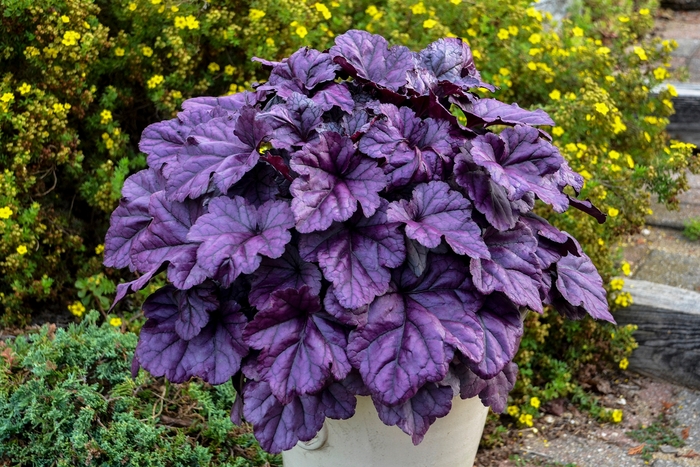« Previous Plant | Next Plant »
Heuchera (Coral Bells)
Dolce® 'Wildberry'
The intense purple color of these leaves are second to none! The foliage is large, a rich hue, and holds onto its purple color for much of the season. Large, scalloped, incredibly glossy leaves are a bold shade of purple. Charcoal veins accent the leaf color that make the leaves really pop. Dark stems hold rosy pink calyxes and white flowers. A must have! Coral bells are easy to grow and blend easily with most other perennials in the landscape. Because of their low, mounding habit, they are often used as edging along paths or in containers. Try cutting a few of the tall flower scapes for fresh bouquets.
- » Intense purple foliage color
- » Charcoal veins accent the leaf color
- » White flowers on dark stems
- » Use as edging or in containers
Heucheras are easy perennials to grow and fit nicely in the front of any border, rock garden, or container. They grow most vigorously and have the strongest colors when grown in partial shade (preferably afternoon shade). They can also be grown in full shade but their growth rate will be very slow. Some varieties can withstand full sun in northern climates if they have consistent moisture, but their colors tend to fade with the intensity of the sun. The soil should be amended with organic matter prior to planting. It should also have good drainage and a neutral pH. Heucheras are evergreen in areas with mild winters. If properly sited out of the way of winter winds and with reliable snow cover, gardeners in northern regions may also find their heucheras acting as evergreens. If the plant looks tattered by early spring, shear off any damaged leaves to make room for the vibrant new foliage which will fill in quickly. Heucheras can be grown under Black Walnut trees because they are resistant to the toxin Juglone which the trees emit from their roots. Heucheras are also salt tolerant. They are useful in the north along pathways which are salted in winter or for people gardening in coastal regions. Occasionally in northern regions, heucheras have a tendency to heave out of the ground because of the freeze thaw cycle. To combat heaving, add an extra layer of compost around the plant's roots in the fall. In the spring, if the plants have heaved at all, the new roots will grow into the fresh new layer of compost.
- Height
- 10 - 28 in
- Spread
- 16 - 20 in
- Zone
- 4-9
- Color
- White
- Categories
- Perennial
- Breeder
- Proven Winners
- Tags
- Attracts Butterflies; Attracts Humming-birds; Border or Bed; Container; Cut Flower/Foliage; Great Foliage
Check back soon for additional information on Dolce® 'Wildberry'.
Heucheras are easy perennials to grow and fit nicely in the front of any border, rock garden, or container. They grow most vigorously and have the strongest colors when grown in partial shade (preferably afternoon shade). They can also be grown in full shade but their growth rate will be very slow. Some varieties can withstand full sun in northern climates if they have consistent moisture, but their colors tend to fade with the intensity of the sun. The soil should be amended with organic matter prior to planting. It should also have good drainage and a neutral pH. Heucheras are evergreen in areas with mild winters. If properly sited out of the way of winter winds and with reliable snow cover, gardeners in northern regions may also find their heucheras acting as evergreens. If the plant looks tattered by early spring, shear off any damaged leaves to make room for the vibrant new foliage which will fill in quickly. Heucheras can be grown under Black Walnut trees because they are resistant to the toxin Juglone which the trees emit from their roots. Heucheras are also salt tolerant. They are useful in the north along pathways which are salted in winter or for people gardening in coastal regions. Occasionally in northern regions, heucheras have a tendency to heave out of the ground because of the freeze thaw cycle. To combat heaving, add an extra layer of compost around the plant's roots in the fall. In the spring, if the plants have heaved at all, the new roots will grow into the fresh new layer of compost.
